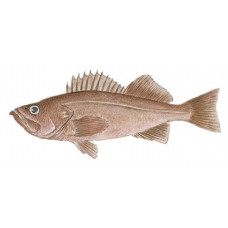Latin name
Sebastes paucispinis
Other names
Bocaccio
Identification
Body prostrate. Head elongated, pointed, mandibles strongly protrude forward. The upper part of the head has only nasal and coronal spines. Tail fin with a notch, pectoral and pelvic fins do not reach the anus. Characterized by the presence of bony plates or spines on the head and body, a large mouth and pelvic fins attached forward next to the pectoral fins. The spines are poisonous, and although they are not very toxic, they can still cause pain and infections. The coloration of the back is olive-brown, changing to pink on the sides. Species shorter than 25 cm have small brown spots on the sides. Some species have a bright coloration. The fish look like perchlike or basslike and are often called sea bass.
Distribution
About 68 species of rockfish of the genus Sebastes and two species of the genus Sebastolobus live off the coast of North America. Common off the coasts of the states of California and Oregon. Almost all of them are found in waters of the Pacific Ocean. On the Pacific coast of North America, from the California Peninsula (Ensenada) to the southeastern part of the Gulf of Alaska (Cruz Island).
Habitat
Sea-bottom gregarious fish. Widespread mainly in the shelf zone, entering, especially in winter, the mainland slope. Adults in California inhabit the depth range of 50-475 m, mainly - 150-200 m. In the Washington-Oregon area, it is found at depths of 50-570 m and is more often caught in the 100-200 m layer at temperatures of 7-9.5 °C. In the Gulf of Alaska it is found to a depth of 425 m, mainly 75-200 m. Juveniles tend to stay in the pelagic part of the shallow shelf. Rockfish are generally divided into those that inhabit the shallower coastal waters of the continental shelf and those that live in deeper waters at the edge of the continental shelf. The former include species that are always found in areas with rocky bottoms (biologists call them shelf demersal) and those that spend most of their time in the water column and near the bottom (shelf pelagic).
Size
It grows relatively quickly, in California already by the end of the first year of life the length of individual specimens reaches 17 cm, by the end of the third year - exceeds 34 cm. The age limit is about 30 years, with a length of 103 cm and a weight of 12.5 kg. The trawl catches off California are dominated by fish 50-68 cm long at 12-17 years of age. In the Washington-Oregon area, fish of 48-62 cm in length and 10-15 years of age dominate the catches.
Life history and Behavior
At the age of 3 years, they begin to give birth. However, 50% of fish first hatch larvae at 4 years of age at 40 cm in length. In the Washington-Oregon region, they grow slower than in California and mature at 5-6 years of age at 30-35 cm in length.
Food and feeding habits
In the Washington-Oregon region, it feeds primarily on juvenile bass and charcoal fish, herring, smelt, myctophids, California anchovy, etc., and cephalopod mollusks. Deciduous crayfish are rarely eaten. California anchovy, sardine, juvenile bass, myctophids, sand lance, as well as cephalopod mollusks, small crabs, etc. dominate the diet.
Reproduction
A viviparous fish. The hatching period of larvae is highly prolonged; in California it lasts from October to March. The number of hatchlings varies from 200,000 in fish up to 38 cm long to 2,300,000 in fish 75 cm long.
| Classification | |
| Phylum | Chordata |
| Class | Actinopterygii |
| Squad | Scorpaeniformes |
| Family | Scorpaenidae |
| Genus | Sebastes |
| Species | S. paucispinis |
| Features | |
| Conservation status | Critically Endangered |
| Habitat | Pelagic |
| Life span, years | 25 |
| Maximum body weight, kg | No information |
| Maximum length, cm | 91 |
| Sailing speed, m/s | No information |
| Threat to people | Edible |
| Way of eating | Predator |
Rockfish
Tags: Rockfish



